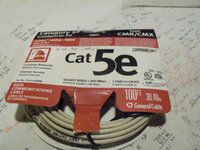I am connecting a Bell Modem in the basement to a booster on the first floor for TV. The modem gets its signal through a fiber optic cable.
Couple of questions.
I wired the RJ45 jacks on both ends of the patch cord according to the T568B standard in a straight through configuration, not crossed. Does it matter? Do the devices take care of straight/crossed wires internally?
I only have Cat 5 cable, not Cat 6, so I used Cat 5 cable. Bell tech support recommended Cat 6. Should I just buy a Cat 6 patch cord?
Couple of questions.
I wired the RJ45 jacks on both ends of the patch cord according to the T568B standard in a straight through configuration, not crossed. Does it matter? Do the devices take care of straight/crossed wires internally?
I only have Cat 5 cable, not Cat 6, so I used Cat 5 cable. Bell tech support recommended Cat 6. Should I just buy a Cat 6 patch cord?

